Welcome to Rhodes
Rhodes is the largest of the Dodecanese islands of Greece and is their historical capital; it is the ninth largest island in the Mediterranean Sea. It is an island which is ideal not only for those who want to relax but also for those looking for an action-packed holiday. With its bright green hills, beautiful valleys and uninterrupted line of golden beaches, Rhodes is truly a blessed place. Add in the excellent facilities for tourism, the island’s special blend of cosmopolitan and traditional, and numerous cultural and archaeological sites and you’ve got the perfect holiday destination. Thanks to its strategic position, Rhodes has been important since ancient times. The ancient city of Rhodes, the construction of which began in 407 BC, was designed according to the city planning system, devised by the greatest city planner of antiquity, Hippodamus of Miletus. Rhodes, soon developed into one of the most important seafaring and trading centers in the Eastern Mediterranean. When it became a province of the Roman, and later the Byzantine Empire, it initially lost its ancient glory. But in 1309 the Knights of Saint John of Jerusalem conquered Rhodes. They built strong fortifications to protect the island, turning it into an important administrative center and a thriving multinational medieval city. In 1523 Rhodes was conquered by the Ottoman Turks, and the Greeks had to settle outside the city walls. During the Ottoman occupation, new buildings were erected within the Old Town, mainly mosques and baths. In 1912 Rhodes and the rest of the Dodecanese, were seized by the Italians. The new rulers embellished the city with magnificent buildings, wide roads and squares. The Palace of the Grand Master was rebuilt and the Street of the Knights was reconstructed in order to regain its medieval purity. It was not until 1948 that Rhodes officially became part of Greece. In 1988 the Medieval City of Rhodes was listed as a UNESCO World Heritage site.
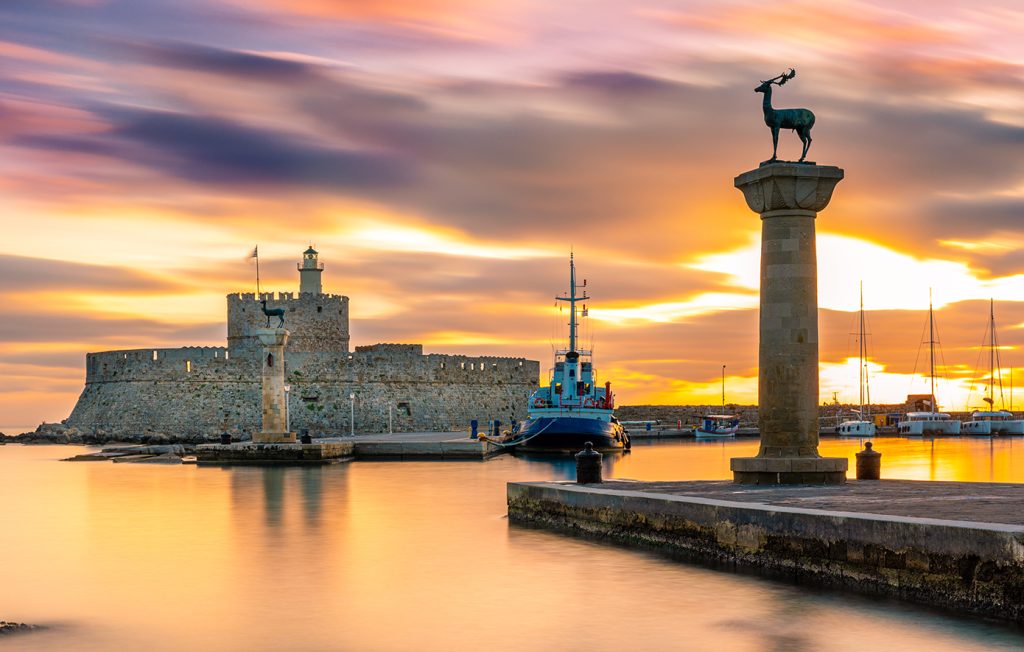
At the same time cosmopolitan and traditional, timeless and modern, simple and spectacular – Rhodes is an island in Greece that has so many faces and you’ll discover them all. The medieval Old Town, port of Mandraki, Acropolis of Lindos, ancient cities of Kamiros and Ialysos, Valley of the Butterflies… Rhodes has so many highlights, that one visit is never enough. The landscape of this Dodecanese island has so much eye-catching beauty that it’s no wonder Rhodes is one of the most popular holiday destinations in Greece. This is where vast sandy beaches, clear waters, castles and ancient civilisations effortlessly mix with gourmet restaurants and traditional tavernas serving local delicacies. Rhodes is a beautiful mosaic of experiences: the island of knights and the mythical Colossus of Rhodes, where Byzantines, Greeks, Venetians and Turks all left something to remember them by. Alongside luxury resorts are villages where women still bake bread in an outdoor wood-fired oven.
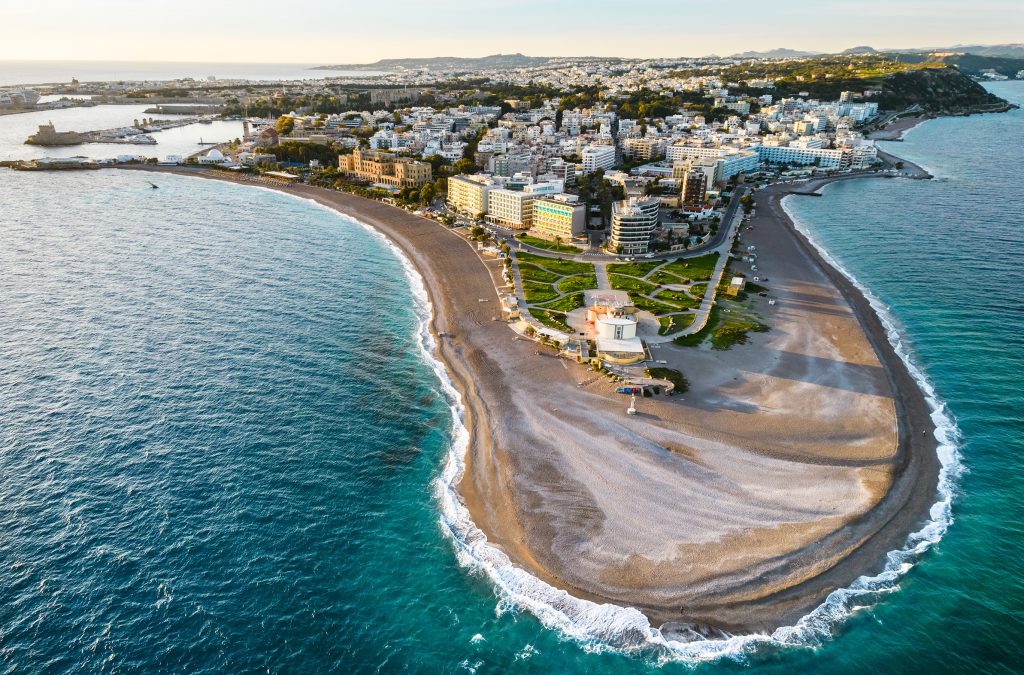
The Old Town of Rhodes is considered one of the most beautiful in all of Greece, smelling of leather, spices and coffee – of the Orient. Even the architecture reminds places of the bazaars of the Far East. The domes of the mosques and the slender minarets, bear witness to Turkish rule. The magnificent buildings of the knights, such as the mighty Grand Master’s Palace, are even more impressive. An unbelievable variety of shops, tavernas and cafes have established themselves there, with holidaymakers from all over the world, bringing life to the old streets. The most beautiful view over the city and the Mandraki harbor is offered by a walk on the old city wall. There is a picturesque labyrinth of alleys, lined with beautiful inner courtyards, mosques next to chapels from the Byzantine era, as well as Turkish fountains and ruins of Gothic churches. One of the best-preserved medieval settlements in the world, the Old Town of Rhodes has been declared a UNESCO World Heritage Site. Protected inside its imposing walls – a boundary between past and present – is the island’s coat of arms. Every stone tells a story. Ancient statues, marble crests, fountains, mosques and hammams, the Clock Tower with its breathtaking view of the Aegean… a rich heritage left behind by past civilisations.
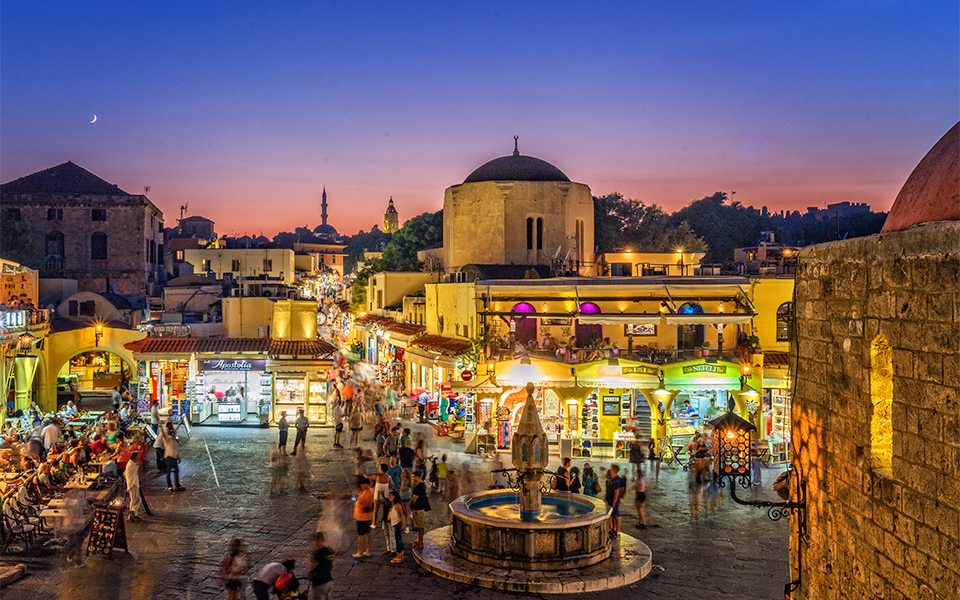
The Archeological Museum of Rhodes
The Archaeological Museum of Rhodes is housed in the medieval building which served as the Hospital of the Knights of St. John. The structure’s construction, begun in 1440, by Grand Master de Lastic, with money which were bequeathed by his predecessor, Fluvian, and was completed in 1489 by Grand Master d’Aubusson. The museum is a two-storey building, with a central courtyard, all four sides of which are lined with porticoes. Interesting finds, dating from all periods of the island’s history, discovered during archaeological excavations, are exhibited in the Garden and in the twenty rooms of the upper floor. In the garden the visitor can see sculptures and funerary steles, as well as the mosaic floors of the Hellenistic period and under the atrium, one can see the mosaic floor of the early Christian period from Karpathos. Various statues and fragments of funerary monuments are also on exhibit in the Museum atrium. The Museum houses the following collections:
Funerary slabs from the period of the Knights with relief representations of the deceased or of their coats of arms
Tomb groups from ancient Ialysos of the Geometric and Classical periods: vases, figurines, jewellery, metal objects
Tomb groups from ancient Kamiros of the Geometric and Classical periods: vases, small objects, figurines
A collection of Classical, Hellenistic and Roman sculptures
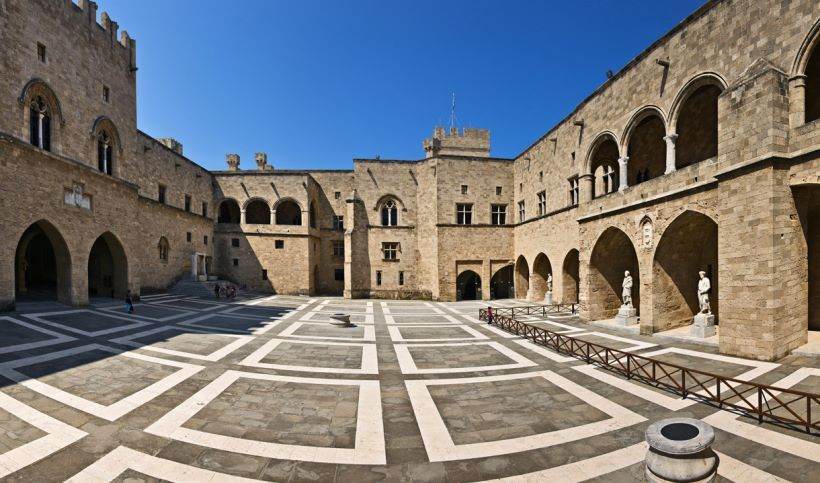
Ialyssos Archeological Site
The district of Ialysos, encompassing the northern part of the island, was inhabited in the prehistoric period. Remains of a Minoan settlement have been found in Trianda and Mycenaean cemeteries have been located on the surrounding hills of Makria Vounara and Moschou Vounara (1700-1400 BC). The ancient city of Ialysos extended around the hill of Philerimos, which was the ancient acropolis where remains of buildings from the Archaic, Byzantine and Knights’ periods, still stand. The temple of Athena Polias, which dates to the 3rd-2nd c. BC, was built over the site of an earlier Classical temple, judging from the evidence of a 5th c. BC floor and terra-cotta antefixes found there. The depository on the west side produced pottery and votive offerings dating from the 9th to the 5th c. BC. In addition to the cult of Athena Polias, there are also references to a cult of Zeus Polias. In the Early Christian period (5th-6th c. AD) a three-aisled basilica with an atrium was built over the remains of the ancient temple, in the north aisle of which, a single-aisle church with a cupola was constructed in the 10th c. At the time of the Franks, this site was occupied by a medieval monastery and church. The more important buildings of the archaeological site include:
The Temple of Athena Polias, thus is a Doric amphiprostyle, tetrastyle or hexastyle temple (that is, with a portico of four or six columns at either end) with a pronaos, cella and opisthodomos. In the cella stands the base of the cult statue. Small column drums and walls inside the cella may have belonged to an interior colonnade (3rd-2nd c. BC). Cuttings on the west side of the rock would have been used as depositories for votive offerings or cult purposes.
Doric fountain-house, two tunnels brought water from the top of the hill to a cistern cut into the rock and closed by a poros isodomic wall in the form of a Greek pi (Π). Lion-head spouts discharged the water from the closed cistern into an open tank, which was enclosed by six pillars with stone panels between them, and from there to a portico of six Doric columns which formed the facade of the fountain-house (4th c. BC). A sacred law with proscriptions for the protection of the fountain-house was carved on one of the pillars.
Church of the Knights, period from the 14th c. with a vaulted roof and two hexagonal chapels.
Baptistery of a three-aisled Early Christian basilica, built over the ruins of the temple of Athena.
Byzantine fortifications, these are on the east side of the hill and constructed with material taken from the ancient temple of Athena. Visible are parts of the repairs, made by the Knights.
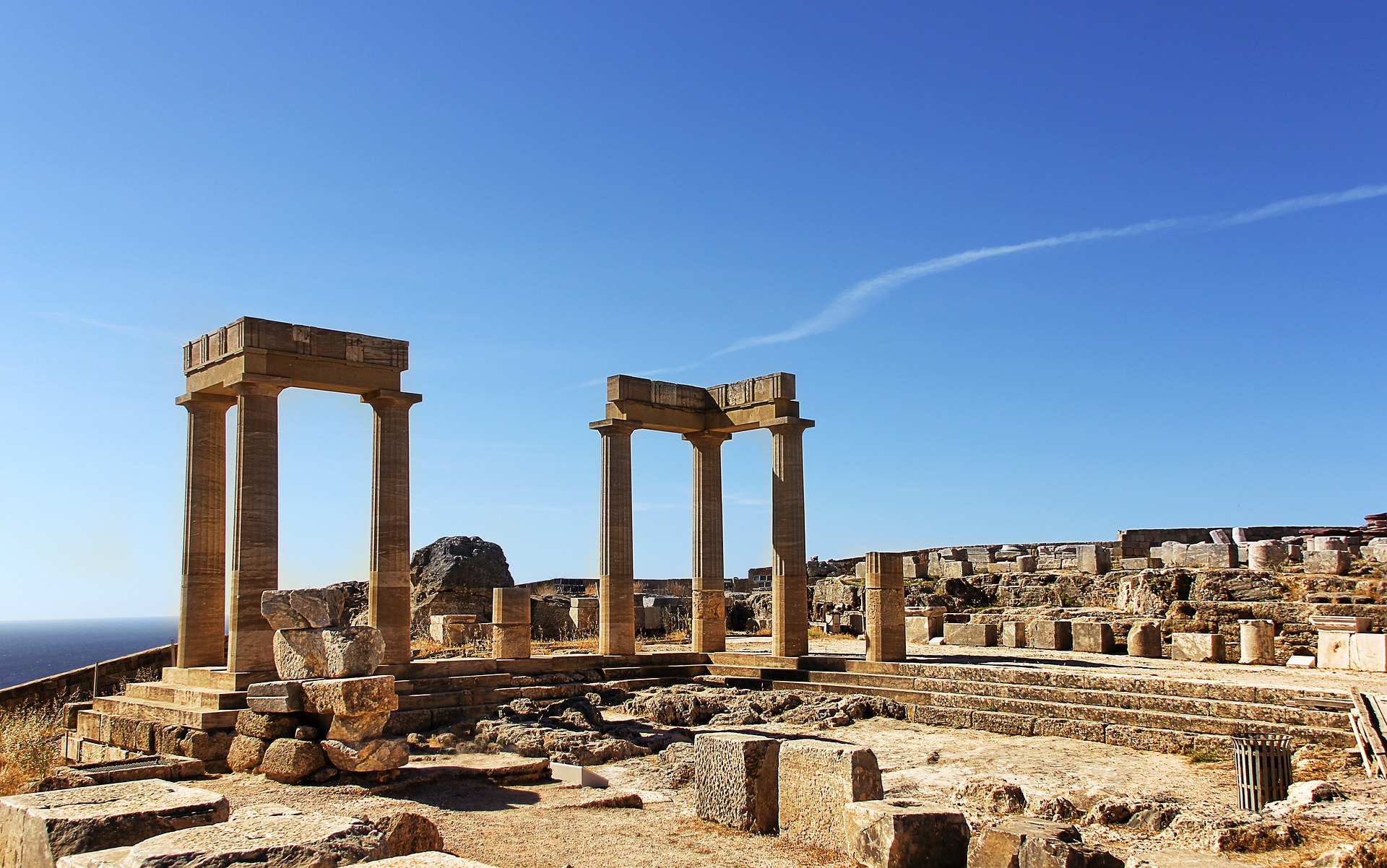
Lindos Archeological Site
The archaeological site includes: Theatre: Located on the southwest side of the hill, below the Temple of Athena, the circular orchestra and the auditorium for the spectators were hollowed out of the side of the hill. The proedries, officials’ honorary seats around the orchestra, still stand proud. The auditorium has19 rows of seats below the diazoma and 7 above it. The first three rows were also intended for officials and the low walls at on their sides, separated them from the auditorium staircases. Only five of the nine cunei have survived. The theatre held 1.800 spectators.
Four-portico building: There are remains of a four-sided building in the extension of the skene of the Theatre. On the inside columns, on all four sides, supported a pitched roof and surrounded an open-air courtyard. The entrance on the northwest side had a porch (row of columns), which carried an architrave. The building held 1.500-1.700 spectators and was intended for religious ceremonies. At a later period the place was occupied successively by three Christian churches.
Boukopion: At Vigli, northeast of the Acropolis, was the Boukopion, a sacrificial place, as the name implies. 38 inscriptions on the rocks around, identify the site. A naiskos built of small field stones with a temple, pronaos and kind of vestibule, contained the votive offerings (clay and bronze figurines chiefly of oxen) to a deity, at present unidentified (10th-9thc. BC).
The ancient Lindos cemeteries where spread over the surrounding district, with the most two important, funerary monuments being:
“The Tomb of Kleoboulos”: This has no connection with the tyrant of Lindos, but was the tomb of a wealthy family. It is a circular structure with carefully built masonry and a vaulted roof. The doorway has a cornice, decorated with palmettes. On the inside, a bed, hewn out of the rock, was a kind of sarcophagus and had a cover, which has not survived (2nd-1stc. BC). Traces of wall-painting and the name “Ayios Aimilianos” testify to its conversion into a Christian church, at a later period.
The Archokrateion: In the locality of Kampana at Krana, on the west hill of the Acropolis, there is a rock-cut tomb. The exterior facade has two stories; half-columns on the ground floor, supporting an architrave with metopes and triglyphs, and on the upper floor pillars alternate with blind openings. On the first floor façade, funerary altars were erected with the names of the dead inscribed on their bases. On the inside, a passage led to a place for burial rituals. A total of 19 graves are cut into this chamber walls. On the sides of the hall, pillars alternate with plaster panels. Its modern name of “Frangokklesia” suggests that it was used as a church during the Knights’ period.
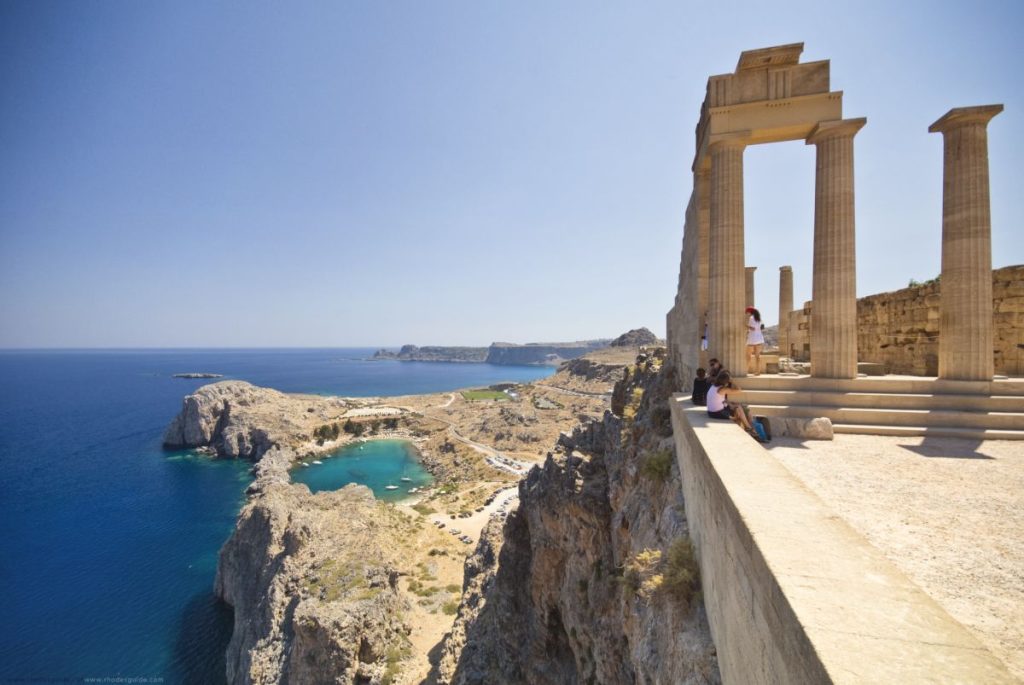
The Valley of the Butterflies
(Museum of Natural History – Holy Monastery Kalopetra)
Taking the western road (provincial road Rhodes – Kamiros) and shortly beyond the village Paradisi, turning left towards Psinthos and before arriving the village, there lays the Butterfly Valley. The route begins at the northern entrance of the Valley, where the Museum of Natural History is located, at an altitude of 150 meters. The path length is 1300 meters and ends at the Holy Monastery of Panagia Kalopetra at an altitude of 470 meters. The trail is organized by bridges and wooden rails and has an entry fee which includes a visit at the Museum. It is a comfortable and pleasant walk along the verdant valley, with the small waterfalls and ponds. The Valley of the Butterflies, another of the island’s landmarks, is the only natural forest in Europe for a species called Ygramvari (Zitia).
The “Zitia” tree, hosts millions of butterflies, which peacefully assemble on the shadowy wet paths it creates with the brook, occasionally transforming to lakes and small waterfalls.
During August, thousands of butterflies of the genus Panaxia (species Quadripunctaria Poda) swarm into the butterfly valley in order to reproduce. During the rainy period, the butterflies, still in the caterpillar stage, remain in the Mediterranean thicket (arbutus, myrtle and rush) feeding on the foliage. As the end of the wet season approaches, towards the end of May, the final stage is concluded and the butterfly in all her perfection, makes her appearance in the recognizable to us all, form. They move constantly towards areas with high humidity, always following the “water ways”, and as the dry period progresses, they finally arrive at the valley.
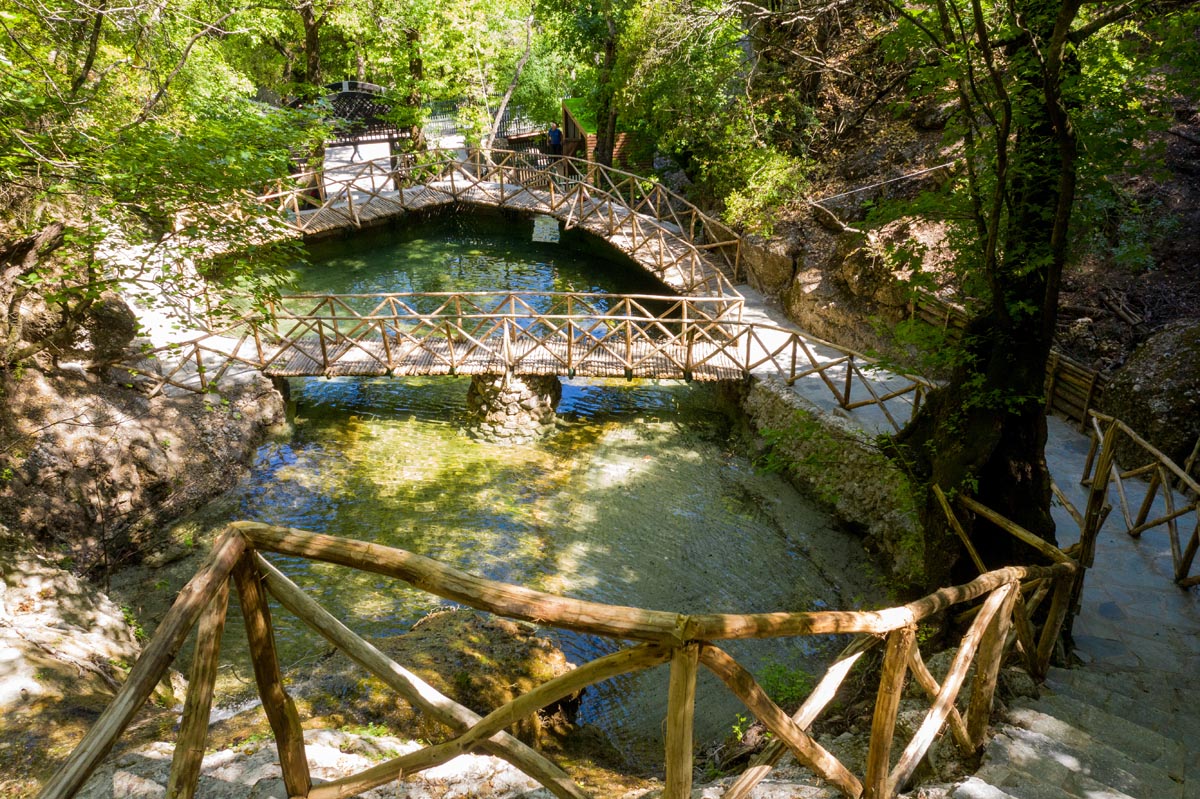
Corfu Kanoni and Mouse Island
The location of Kanoni with the church of Panagia Vlacherna below and the Mouse Island (Pontikonisi) are the most famous and photographed spots of Corfu. Kanoni is actually a district of Corfu Town, just a couple of kilometers from the city center. It took its name from an old cannon that stands on top of the hill. This hill is lush green and has many luxurious hotels and local residences. Some steps go down the hill from Kanoni; after descending, you reach the small church of Panagia Vlacherna. A narrow 300m passageway connects the island with the church. Constructed in the 17th century, this lovely chapel has an impressive wooden-carved iconostasis and beautiful frescoes inside. The roof has red tiles and above the gate entrance appears a tall bell tower. Fishing boats depart frequently from the church and go to the legendary Mouse Island in just 5 minutes. The green island was named like that due to its tiny size. According to mythology, this is the ship of Odysseus that was stoned by the god Poseidon. In the center of Mouse Island, there is the 13th-century church of Pantokrator. This church celebrates on August 6th when a large religious fest (panigiri) takes place. On top of the hill in Kanoni, lie two cafeterias with amazing views of the church of Vlacherna, the sea, and Mouse Island. It is also very usual to see an airplane landing and taking off from this spot, as the airport of Corfu is right next to the church. Another longer passageway connects the church of Vlacherna with the opposite area of Perama.
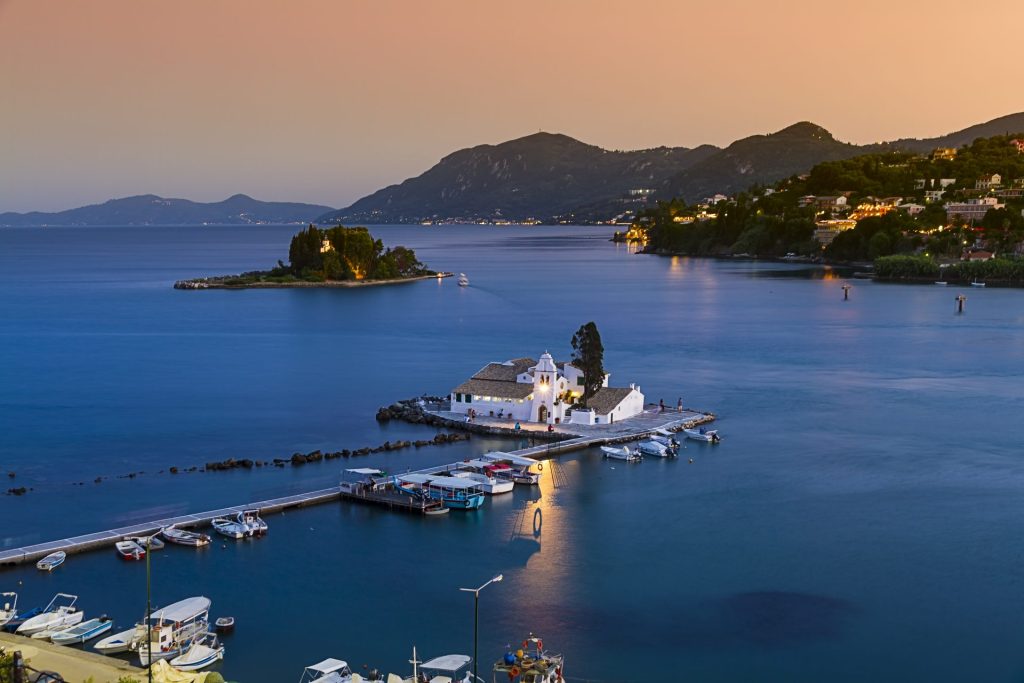
Achillion Palace
The Achillion Palace is ideally located in the picturesque village of Gastouri. This magnificent Palace was built in 1890 for the former Empress of Austria, Elizabeth (Sissy). The building used to serve as her summer retreat. Unfortunately, the Empress passed away in a rather tragic manner when she was brutally assassinated in 1898 in Geneva and the palace was deserted until 1907 when it was bought by Kaiser Wilhelm II of Germany. The palace is located in a place of mesmerizing beauty with the coast down below, which still has the jetty where the Kaiser would embark on his cruises. The Palace is not only renowned for its classical features. The impeccable palace garden is absolutely top-class and makes for a picture-perfect setting. Legend has it that the Empress fell so much in love with Corfu, that she ultimately decided to build a residence that she could call her own. The palace is located at the spot where the manor of the renowned philosopher Petros Vrailas Armenis stood. Empress Elisabeth was also captivated and awestruck by ancient Greek legends and mythology. Her favorite hero was Achilles on whose honor she dedicated the palace. The garden of the palace is replete with rather artistically sculpted statues of the pantheon of Greek Gods and Goddesses that makes for a truly mythical setting.
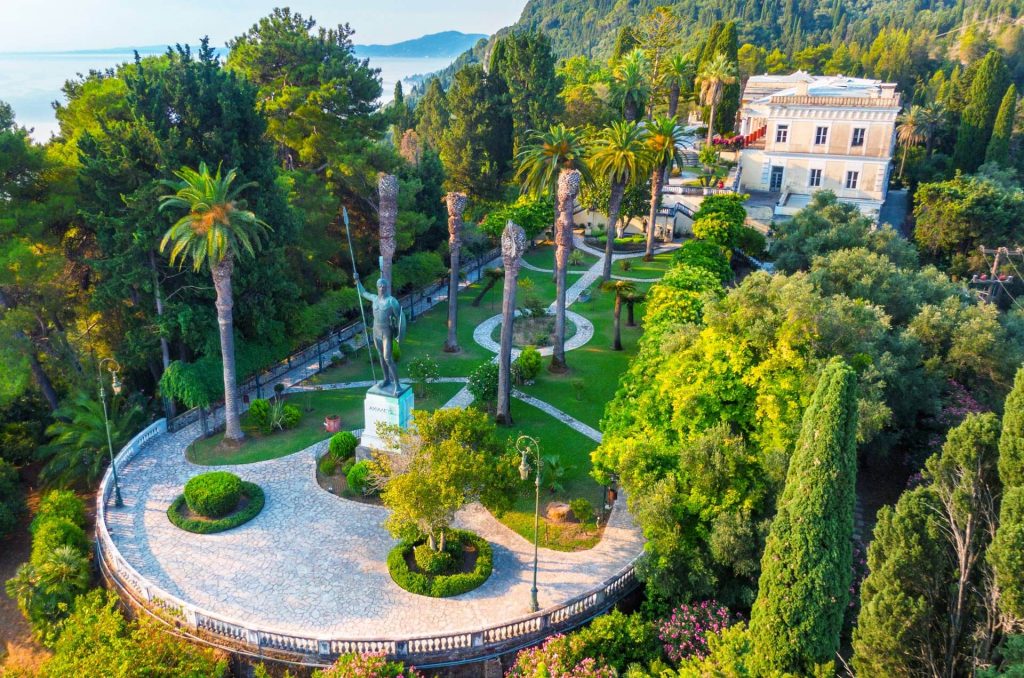
Mon Repos Palace
Mon Repos Palace is situated on top of Analipsis Hill, near the Kanoni area, in the middle of a beautiful setting full of greenery. It was built in 1826 by British Commissioner Frederic Adams as a gift to his wife, Nina Palatianou, who came from Corfu. It is a small but very beautiful palace with colonial architectural elements. Later on, the palace became the summer residence of all British governors of Corfu and when the Ionian Islands were united to Greece, in 1864, it was given as a gift to King George I of Greece. This is also the house where Prince Phillip, Duke of Edinburgh, the husband of Queen Elisabeth II, was born on June, 10th, 1921. During the Italian occupation of Corfu, in the Second World War, this palace became the residence of Parini, the Italian governor of the Ionian Islands.
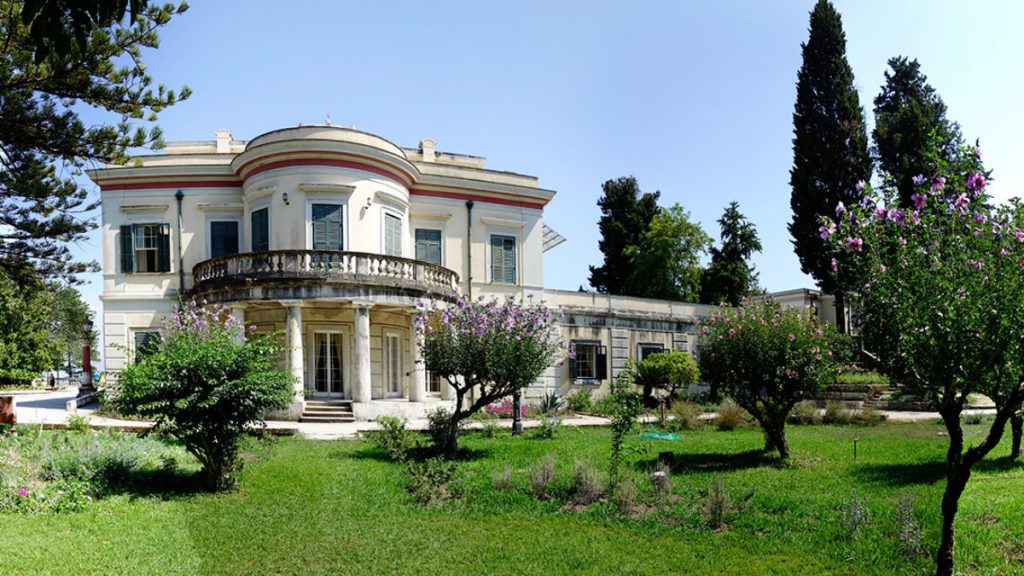
Angelokastro Castle
Angelokastro, also referred to as Angel Castle, is strategically located in proximity to Krini. It is believed to date back to the 13th century. Angelokastro is conspicuous by its domed gate at the entrance. It boasts of priceless vestiges and there are exclusive storage rooms as well. Another interesting remnant is an ancient church dedicated to the angels Gabriel and Michael which is surprisingly constructed in a cave. Legend has it that an ancient emperor was on the lookout for a precipitous rock to build a fortress so that it could easily thwart most pirate attacks. With this in mind, the emperor stumbled upon the neighborhood of Angelokastro where he came across the towering fortress that was reportedly built by the then Archbishop of Epirus. The primary reason why the fort was built was to shield the inhabitants from pirate attacks. The major threat emanated from pirates from Africa and the Venetians. According to historical records, Angelokastro was the capital of the island of Corfu and the Governor himself resided here. Historians are of the opinion that in the infamous pirate attack of 1403, the inhabitants of Angelokastro fought tooth and nail from the fortified castle against the Genoan pirates.
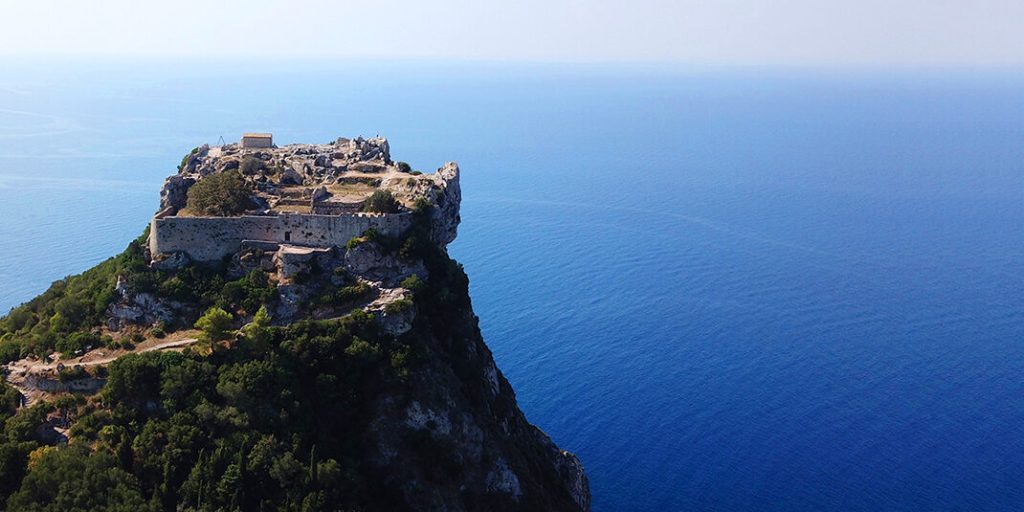
Paleokastritsa Monastery
On a green hill above the beach of Paleokastritsa, on the northwestern side of Corfu, stands a large Monastery complex dedicated to Panagia (Virgin Mary) of Paleokastritsa. This monastery dominates the whole region. Built atop a remote hill, it offers a gorgeous view of the island and the sea. This Byzantine Monastery dates back to 1228, however the current complex, the cells of the monks and the yard date from the 18th century. The monastery has a small ecclesiastical museum with rare Byzantine icons, holy books, and other relics. Inside the monastery lies a traditional olive oil press, too. The road to the monastery passes through a forest of olive trees and cypresses, making the ascend a lovely experience
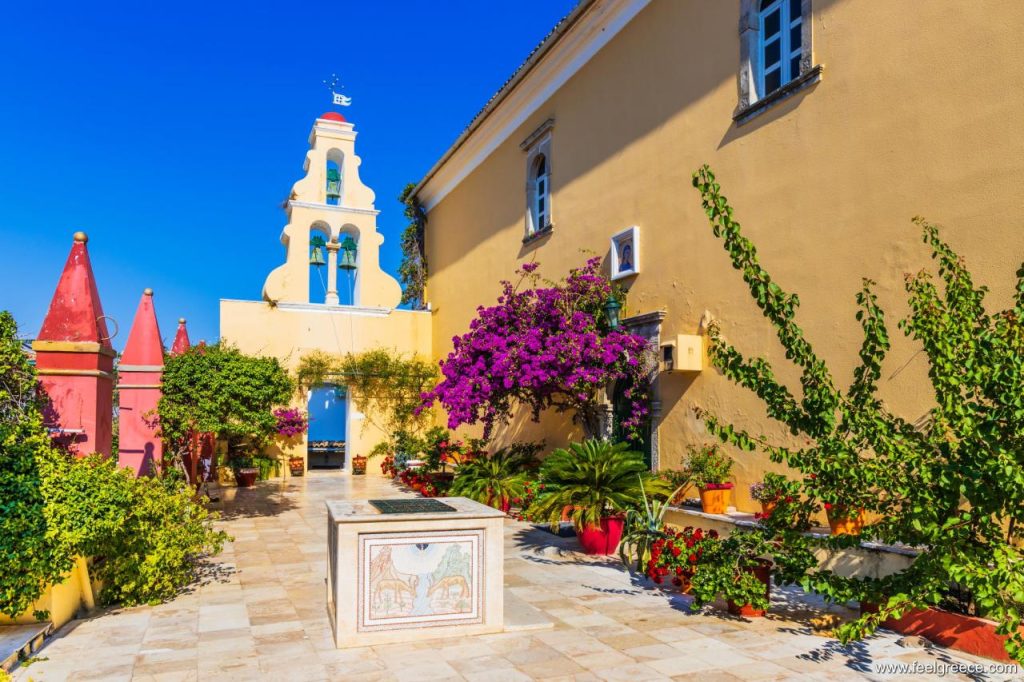
With clean water and surrounded by lush greenery, beaches in Corfu Greece attract many visitors every summer. Both organized and pristine beaches are part of the island’s coastline. The list of beaches is endless, from secluded picturesque coves to large, vibrant stretches of sand with beach bars, tavernas, shops and water sports.
-Paleokastritsa Beach in Corfu: Getting its name from the old fortress at the Monastery of the Virgin Mary (near the Corfu Aquarium), Paleokastritsa consists of about six sand-and-pebble-filled seashores, all of which are surrounded by gorgeous olive trees! The main beach of Agios Spiridon hosts awe-inspiring teal waters and a lengthy, sandy coast in its U-shaped shore.
-Agios Gordios Beach in Corfu: The beautiful west-Corfu shore of Agios Gordios features coarse sand along its golden shore, as well as some gravel! It functions as a prime beach visit amongst all locals and tourists, given that it has a mesmerizing mountainous background and a shallow seabed, making it ideal for families with children! Plus, you can also spot a rusty shipwreck on one end of the shore.
-Rovinia Beach in Corfu: The awe-inspiring Rovinia Beach is one of the finest seashores in the Ionian Sea, boasting a mesmerizing white-pebble seashore mixed with sand, along with dreamy crystal-clear turquoise waters! Snorkeling lovers will love its majestic seabed, whereas experienced swimmers will also have a chance to discover plenty of jaw-dropping sea caves at a swimming distance! Despite its quite steep descent, Rovinia gets quite crowded during the high season.
-Myrtiotissa Beach in Corfu: Located between the villages of Vato and Pelekas, Myrtiotissa is a gorgeous shoreline with fine golden sand and clear teal-colored waters! Showcasing a rocky seabed, it is an ideal visit for snorkeling enjoyers, though the beach is mostly an unofficial destination for naturists! Plus, the beach is surrounded by large olive groves, providing some gorgeous scenery.
-Bataria Kassiopi Beach in Corfu: One of the most picturesque beach destinations in Corfu, Bataria is filled with stunning white-colored pebbles and crystal-clear turquoise waters, creating a gorgeous color combination for your eyes to feast on! Due to its deep seabed, a number of visitors snorkel in the waters of Bataria, though it is also an ideal destination for casual swimming, sunbathing, and enjoying the views toward the mountainsides of Albania.
-Sidari Canal d’Amour Beach in Corfu: Quite possibly the most tourist-filled area in all of Corfu, Sidari hosts the one-of-a-kind Canal d’Amour Beach (translated into Channel of Love). Reminding visitors of a lunar landscape, Canal d’Amour is a unique bay area surrounded by large cliffs. It features crystal-clear waters, coarse sand along its shoreline, a shallow seabed, and a plethora of awe-inspiring narrow caverns and water caves!
-Glyfada Beach in Corfu: Glyfada is a Blue-Flag seashore surrounded by large, beautiful mountains. The beach showcases fine golden sand, clear blue waters, and quite a shallow seabed! Starting off as a quiet shore, Glyfada Beach evolved into a crowded, cosmopolitan beach destination through the years, making it ideal for young adults and for partying purposes
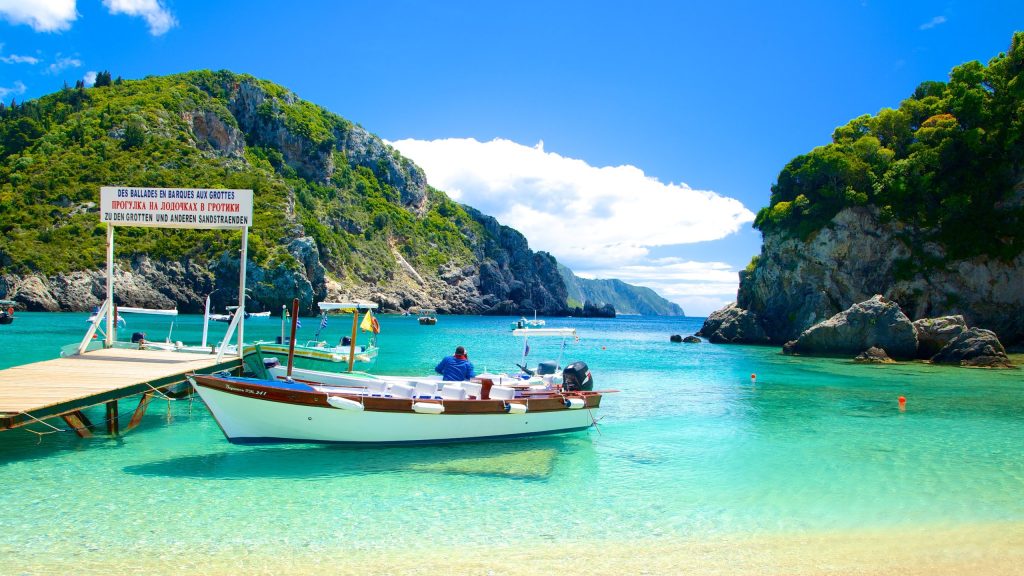
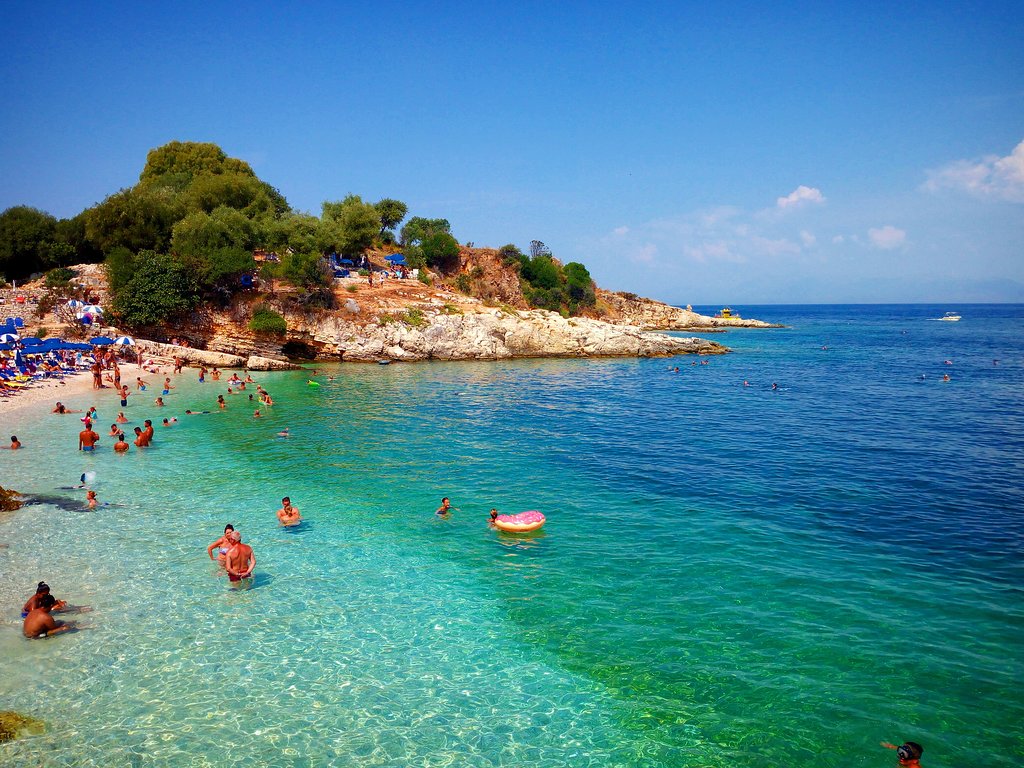
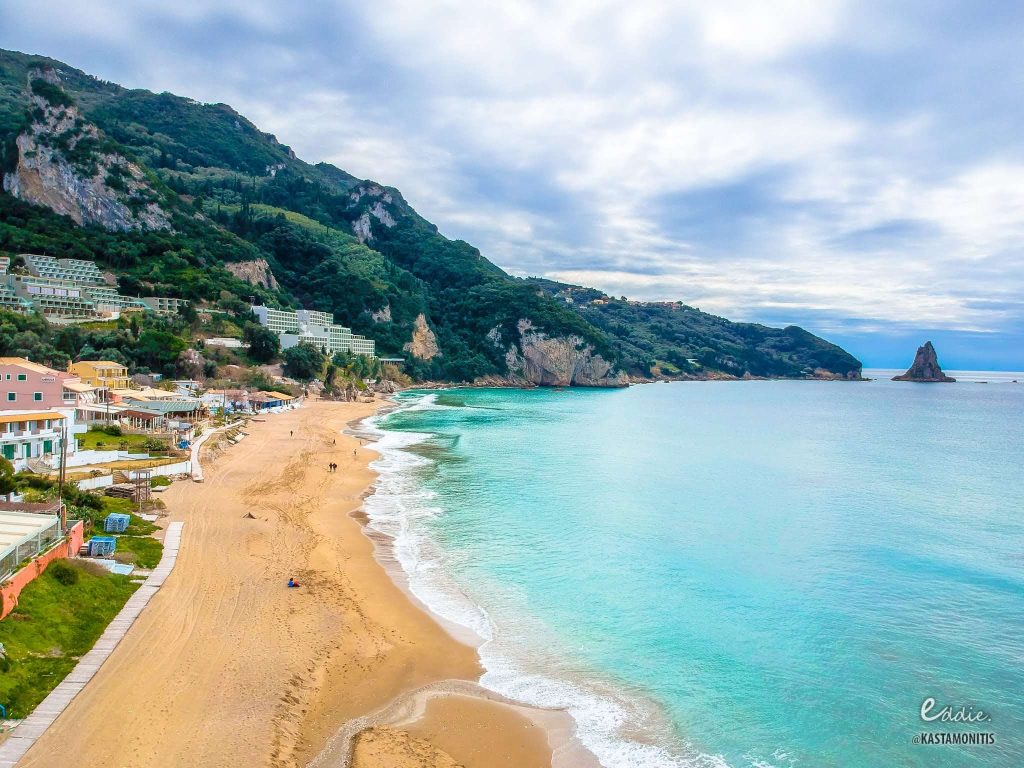
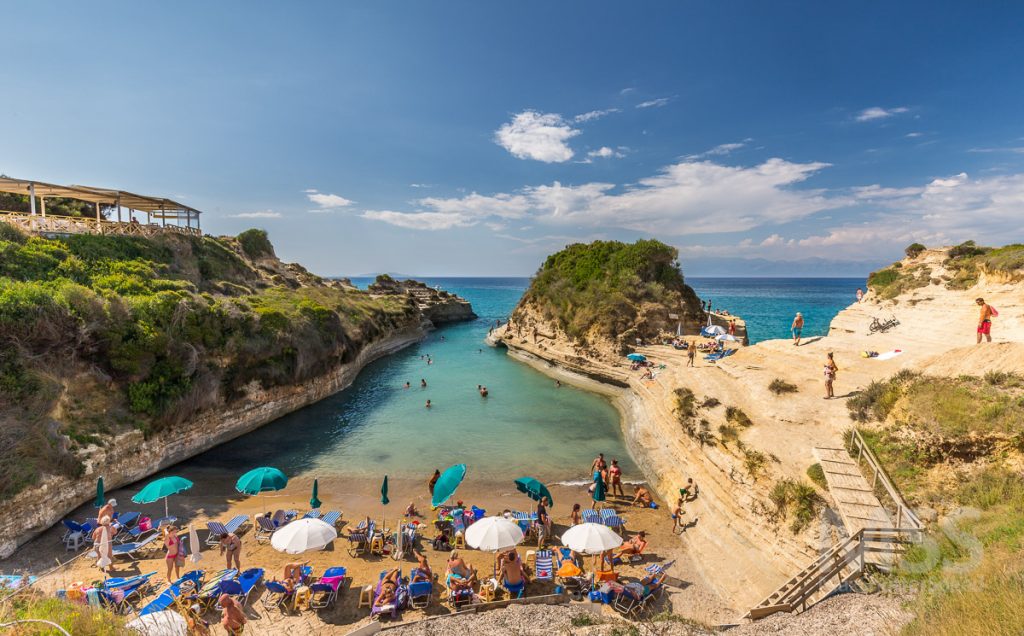
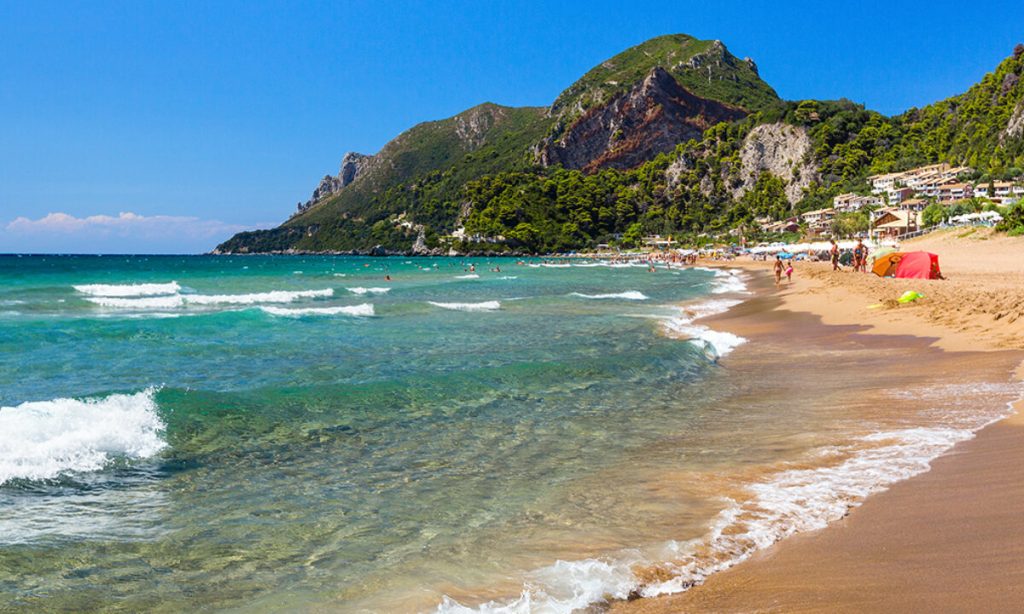
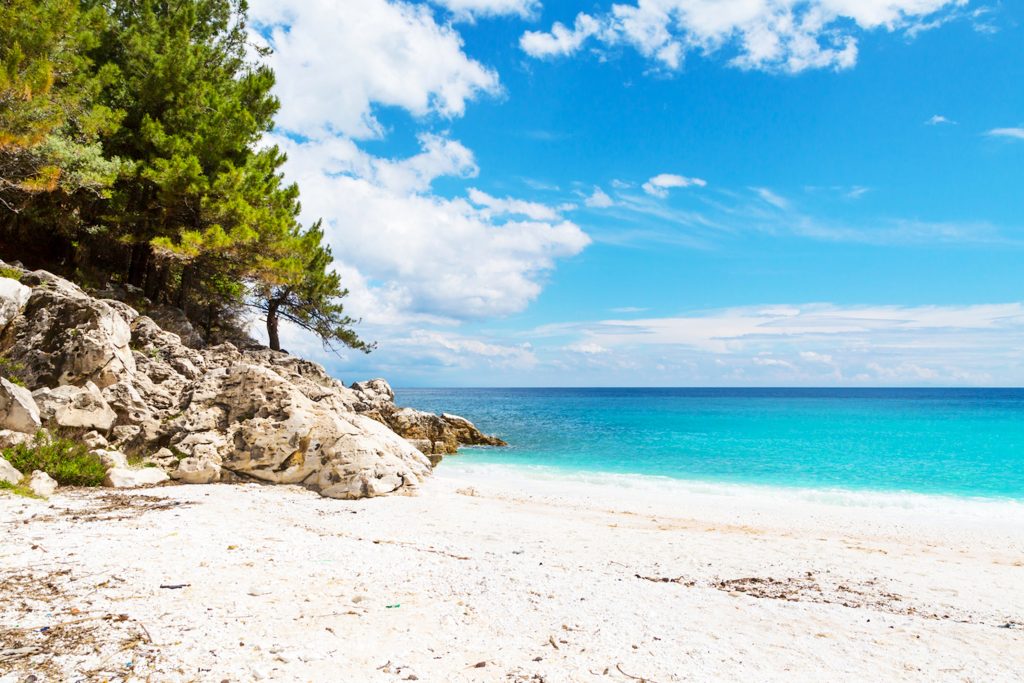
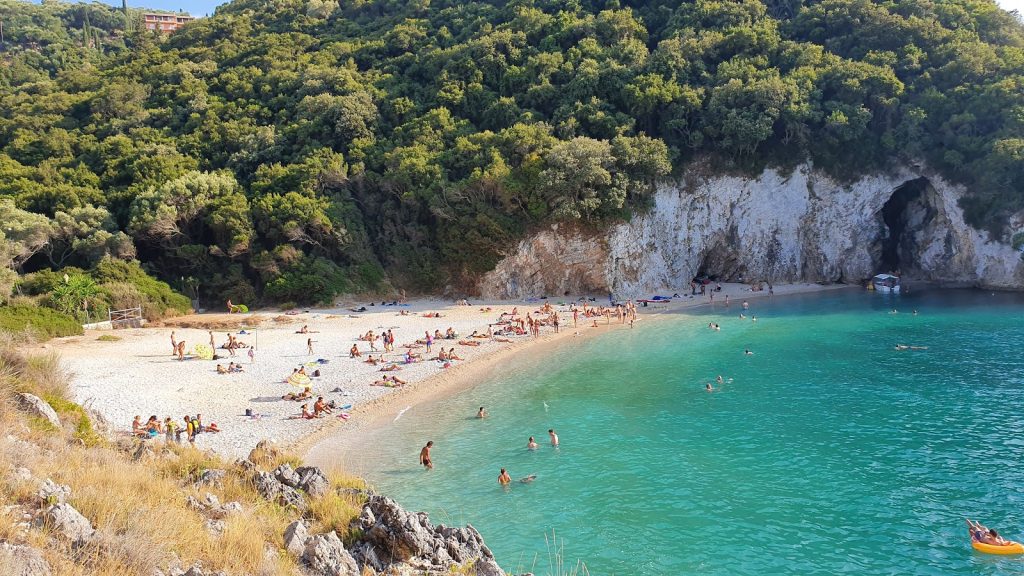
Getting to Corfu
By Ferry
Corfu has ferry services both by traditional ferries to Gaios in the island of Paxoi and as far as Patras and both traditional ferries and advanced retractable airfoil, hydrodynamic-flow, high-speed ferries called “Flying Dolphins” to Igoumenitsa . The small port of Lefkimmi is also to be found at the southernmost tip of the island on Cape Kavos, offering a ferry service to the mainland.
By Plane
Corfu is connected to Athens International Airport, the flight lasts 1 hour but also to Macedonia International Airport (Thessaloniki), it is also connected to other airports in Greece. The airport is called Ioannis Kapodistrias International Airport.
Sources: https://www.greeka.com/ionian/corfu/ , https://www.visitgreece.gr/islands/ionian-islands/corfu/, https://en.wikipedia.org/wiki/Corfu
–